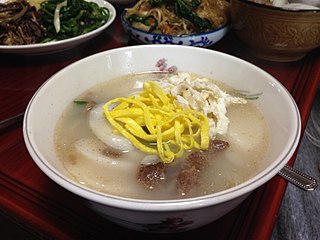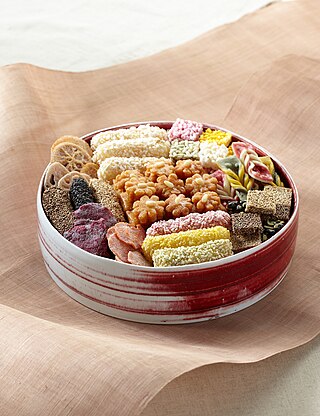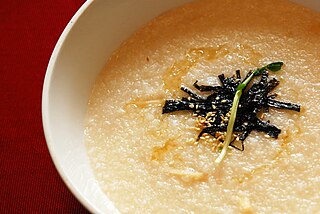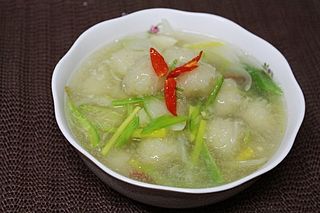
Korean cuisine has evolved through centuries of social and political change. Originating from ancient agricultural and nomadic traditions in Korea and southern Manchuria, Korean cuisine reflects a complex interaction of the natural environment and different cultural trends.

Mizuame is a sweetener from Japan. A clear, thick, sticky liquid, it is made by converting starch to sugars. Mizuame is added to wagashi to give them a sheen, eaten in ways similar to honey, and can be a main ingredient in sweets. Some Mizuame are produced in a very similar fashion to corn syrup and are very similar in taste.

Tteokguk (떡국) or sliced rice cake soup is a traditional Korean dish eaten during the celebration of the Korean New Year. The dish consists of the broth/soup (guk) with thinly sliced rice cakes (tteok). It is tradition to eat tteokguk on New Year's Day because it is believed to grant the people good luck for the year and gain a year of age. It is usually garnished with thin julienned cooked eggs, marinated meat, gim (김), and sesame oil (참기름).

Tteok is a class of Korean rice cakes made with steamed flour made of various grains, including glutinous or non-glutinous rice. Steamed flour can also be pounded, shaped, or pan-fried to make tteok. In some cases, tteok is pounded from cooked grains.

Kal-guksu is a Korean noodle dish consisting of handmade, knife-cut wheat flour noodles served in a large bowl with broth and other ingredients. It is traditionally considered a seasonal food, consumed most often in summer. Its name comes from the fact that the noodles are not extruded or spun, but cut.

Korean noodles are noodles or noodle dishes in Korean cuisine, and are collectively referred to as "guksu" in native Korean or "myeon" in hanja character. Preparations with noodles are relatively simple and dates back to around BC 6000 to BC 5000 in Asia. In Korea, traditional noodle dishes are onmyeon, called guksu jangguk, naengmyeon, bibim guksu, kalguksu, kongguksu among others. In royal court, baekmyeon consisting of buckwheat noodles and pheasant broth, was regarded as the top quality noodle dish. Naengmyeon, with a cold soup mixed with dongchimi and beef brisk broth, was eaten in court during summer.

Hangwa is a general term for traditional Korean confections. With tteok, hangwa forms the sweet food category in Korean cuisine. Common ingredients of hangwa include grain flour, fruits and roots, sweet ingredients such as honey and yeot, and spices such as cinnamon and ginger.

Jeonbok-juk or abalone rice porridge is a variety of juk, or Korean porridge, made with abalone and white rice. Abalone is regarded as a high quality ingredient in Korean cuisine and was often presented as a gift to the king of Korea. The dish is a local specialty of Jeju Island where abalones are commonly harvested. Jeonbokjuk is known as not only a delicacy but also as a nutritional supplement and digestive aid, especially for ill patients or elderly people. Jeonbokjuk can be made with or without the abalone's internal organs. The former type of jeonbokjuk has a green tinge while the latter is more ivory in color.

Gamja-ongsimi (감자옹심이) or potato dough soup is a variety of sujebi in Korea's Gangwon cuisine. Both the potato dumplings and the soup can be referred to as gamja-ongsimi. The juk (porridge) made with potato balls as its ingredient is called gamja-ongsimi-juk, and the kal-guksu made with the potato balls is called gamja-ongsimi-kal-guksu.
Korean regional cuisines are characterized by local specialties and distinctive styles within Korean cuisine. The divisions reflected historical boundaries of the provinces where these food and culinary traditions were preserved until modern times.

Yeot-gangjeong (엿강정) is a candy bar-like variety of hangwa consisting of toasted seeds, nuts, beans, or puffed grains mixed with mullyeot. In general households, they usually make and eat yeot-gangjeong during Korean holidays and Jesa. Or, it is made and sold as a winter snack and is usually eaten during holidays and feasts.

Mandu-gwa is a Korean sweet dumpling filled with sweetened ingredients and coated with jocheong. It is a type of yumil-gwa, a deep-fried hangwa made with wheat flour. Mandu means "dumplings" and gwa means "confection". Mandu-gwa is typically eaten as a dessert or bamcham.
Chanochi (차노치) is a Korean dish. It is pink, pan-fried tteok or jeonbyeong (pancake) made with glutinous rice flour. It is a regional dish of the Yeongnam region.

Mu or Korean radish is a variety of white radish with a firm crunchy texture.

Cheong is a name for various sweetened foods in the form of syrups, marmalades, and fruit preserves. In Korean cuisine, cheong is used as a tea base, as a honey-or-sugar-substitute in cooking, as a condiment, and also as an alternative medicine to treat the common cold and other minor illnesses.






















